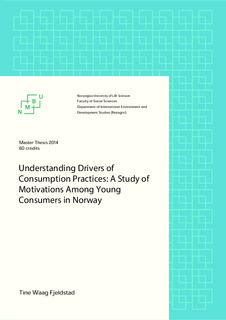| dc.description.abstract | Mass-consumption of clothing is an important contributor to climate change and other environmental problems. This study aims to develop a more comprehensive understanding of the complexities of consumption by looking at two main factors. Firstly, what different motivations are at play for consumption of clothing, and how these motivations intersect and interact. Secondly, how elements of consumer behaviour links to group and individual identity, and the role of clothes in the creation and negotiation of these identities. Lastly the research seeks to better understand linkages between clothes consumption and barriers to behaviour change towards lessening the impact of consumption on the environment. The data is collected through focus group interviews with young consumers in Norway aged 16-18. This provides in-depth qualitative data from consumers in the process of creating their consumer patterns and practices. The findings demonstrate a variety of overlapping and complex motivations for consumption, some of which are hidden from the consumer. The motivations are a mix of internal and external influences. The internal influences include norms and habits, while the sources of external influence include advertising, media and celebrities, as well as parents and peer groups. The relationship between internal and external motivations, or individual agency and structural influence, is complex and filled with tension. There is a clear pattern of contradiction between the consumers wanting to display individuality through consumption of clothing, and wanting to display group belonging. In the mind of the consumer this contradiction is either not apparent or not problematic. The findings suggest that the relationship between consumption of clothing and identity creation is a tenuous one. Clothes are important for identity creation as a form of communication, but only up to a certain degree, and it is not always a successful tool for creating and maintaining identities. The complexity of consumer motivations apparent in this study has implications for policy measures directed towards reduction of consumption. The research shows that there is potential for behaviour change based on the false satisfaction of certain social functions through consumer goods. | nb_NO |
